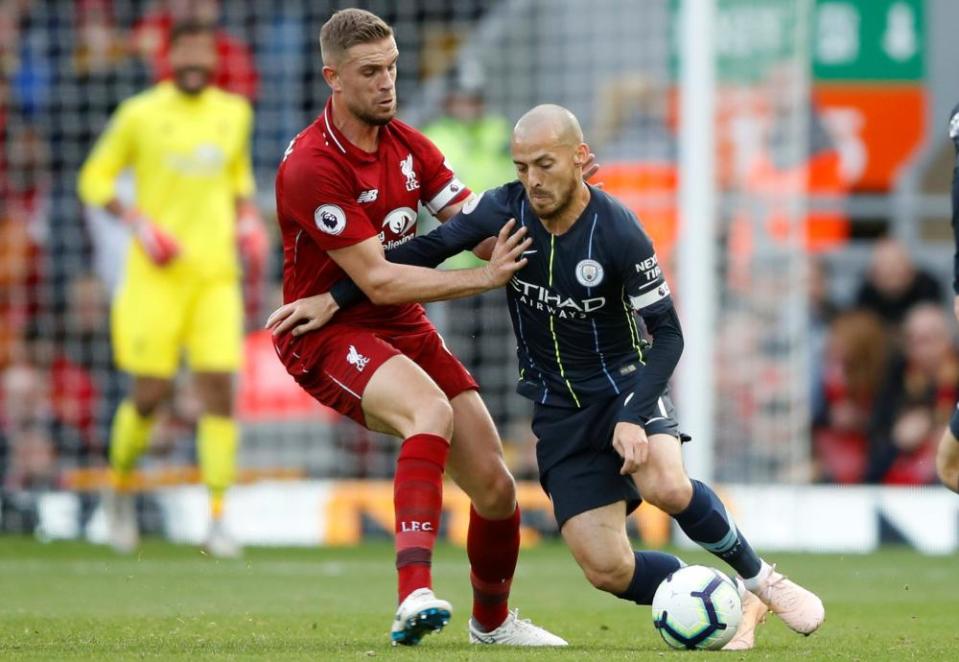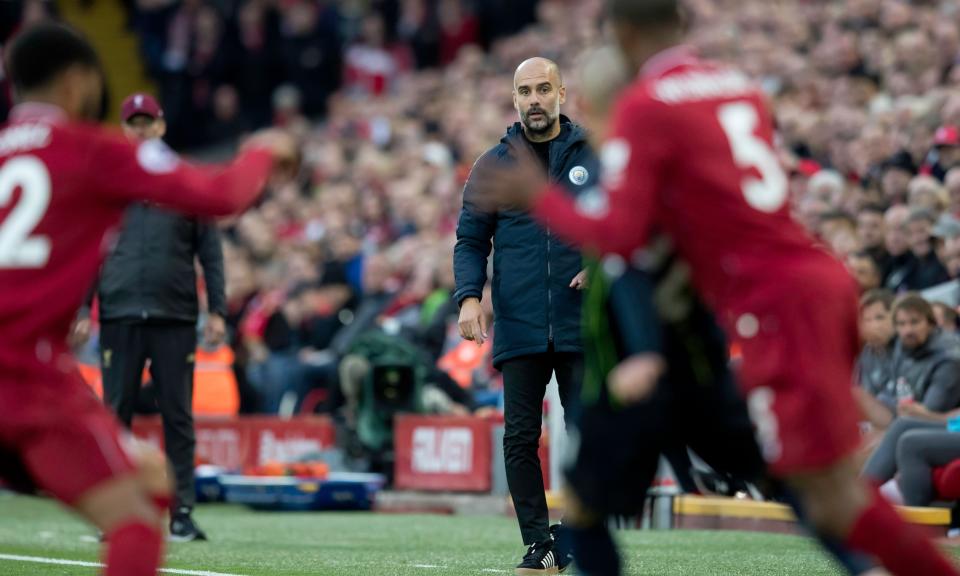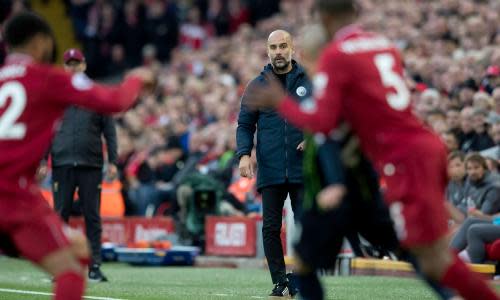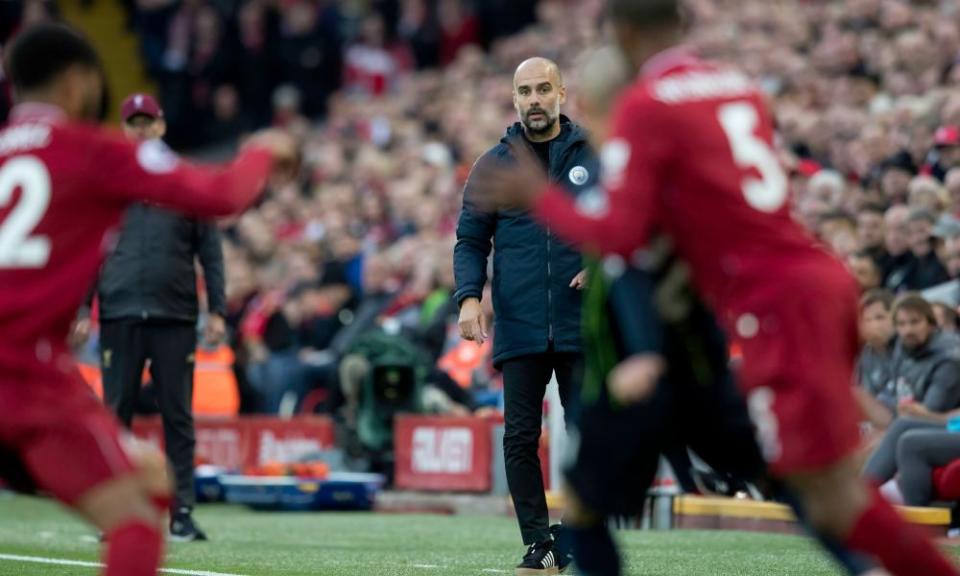The Pep commandments: how lessons learned at Bayern stymied Liverpool
Eighteen games into Pep Guardiola’s second season as manager of Bayern Munich, his side lost 4-1 at Wolfsburg. It was their first defeat of the campaign and a major surprise, and it made Guardiola stop and reconsider. Had he been overthinking things? Had he got so carried away with his experiments in using his full-backs in possession effectively as old-fashioned wing-halves that he had forgotten the basics? Determined he shouldn’t make the same mistake again, he wrote what he came to refer to as “the Bible” on the whiteboard in his office.
It was a very short Bible, containing only three key strictures. He would deploy:
• Two against four in attack
• An extra man in midfield
• An extra man in defence
These were very Cruyffian values, the second and third commandments echoing the line Guardiola had written in his 2001 memoir La meva gent, el meu futbol to explain the thinking of his great mentor Johan Cruyff on basic formations. The priority, he had said, was “to fill the centre of the pitch in order to play having numerical superiority”.
READ MORE: Mourinho seeks public backing from board
READ MORE: Monday Morning Football: A definitive analysis of the weekend
READ MORE: Eddie Hearn takes first tentative steps to conquering America
There are, of course, numerous other factors that come into play when setting up a team, and there have been many occasions when Guardiola has not faced 4-3-3 with 4-4-2, but for Guardiola these three principles form the central idea. And that, perhaps, explains the set-up against Liverpool on Sunday.
Against Liverpool’s three-man forward line, a trident he had admitted before the game that scares him, he deployed a back four. A back three had worked in the 5-0 win at the Etihad last season – and to an extent, before his own dismissal at half-time, in the second leg of the Champions League quarter-final – but, despite the availability of Benjamin Mendy, who gives him the option of setting up with a back three and wing-backs, he preferred a four. Mendy was given a certain licence, but Guardiola avoided the dangers of having both full-backs push on simultaneously by having Kyle Walker play in a more restrained way than usual, often tucking in as a de facto third centre-back.
But it was the shape of the rest of the team that was so striking. Rather than the usual midfield, Guardiola included an extra man, obeying the command to play two against four in attack by deploying a 4-4-2. Fernandinho and Bernardo Silva occupied the centre, supported, as they had to be if they were not to be overmanned, by Raheem Sterling and Riyad Mahrez. The wide players tucked in, playing much deeper than has been usual for wide players at City this season, both helping out in the centre and offering protection for the full-backs.

As it turned out, with Jürgen Klopp also opting to use his full-backs in a more conservative way, bringing in Dejan Lovren and shifting Joe Gomez to right-back in place of the more obviously attacking Trent Alexander-Arnold, the battle on the flanks became much cagier than had been anticipated.
Guardiola had tried to do something similar in the first leg of the Champions League tie last season, when İlkay Gündoğan had been used in a tucked-in right-sided role, with the intention of protecting the full-back and offering City a measure of control that would prevent Liverpool generating the sort of momentum that had blown City away after half-time in the 4-3 in the league at Anfield. It failed on that occasion, but just because the execution went awry doesn’t invalidate the thinking behind it. “If it is an open game at Anfield,” Guardiola said on Sunday, “you don’t even have 1% of a chance. Up and down they are the best team in the world in these transitions.”
The third prong of the plan was the use of David Silva as a second striker just behind Sergio Agüero. That fitted a more general trend that has seen strike pairings begin to re-emerge as it has become apparent that central defensive pairings have forgotten how to deal with two strikers (so both have to mark rather than one marking and the other dropping off as cover) but, because Silva often dropped deep, it also put pressure on the back of Liverpool’s midfield, an area in which they can look vulnerable.
As it turned out, Jordan Henderson had a very good game, but it is difficult for a midfield three to press with full confidence when it is always having to look over its shoulder to see what is happening in the gap between it and the back four.
The game, in truth, was probably not the spectacle most were hoping for, but in applying the lessons of Wolfsburg, in going back to the basics of Cruyffism, Guardiola demonstrated a flexibility and a pragmatism he has often eschewed in the past. It might not be as much fun as the days of “Sorry guys, this is how I play” but in terms of getting results away against elite opponents, it may turn out to be more effective.

 Yahoo Sport
Yahoo Sport 













































